| Pages:
1
..
13
14
15
16
17
18 |
TheMrbunGee
Hazard to Others
  
Posts: 364
Registered: 13-7-2016
Location: EU
Member Is Offline
Mood: Phosphorising
|
|
Quote: Originally posted by PHILOU Zrealone  |
Nice bang! Maybe that the iron plated plate under it contributed as a catalyst...Would be nice to test this onto an inert surface like glazed ceramic.
Most probable reaction:
-No azide at all!
-Under the strong heating you get dehydration/condensation of urea into biuret, triuret and finally into melamine (triamino-sym-triazine)
H2N-CO-NH2 + H2N-CO-NH2 --> H2N-CO-NH-CO-NH2 + NH3(g)
H2N-CO-NH-CO-NH2 + H2N-CO-NH2 --> H2N-CO-NH-CO-NH-CO-NH2 + NH3(g)
H2N-CO-NH-CO-NH2 <==> H2N-C(-OH)=N-CO-NH2
3 H2N-CO-NH2 -heat-> (-N=C(NH2)-)3 + 3 H2O
Then urea, biuret, triuret and especially melamine(*) are fuels; while NaNO2 is an oxydizer.
Into the molten state both are intimately mixed at a molecular level and as such may deflagrate/detonate(**) because the average energy of all the
molecules is already high due to the preheating/melting... just like trowing an enflamed match into preheated dry wood.
Would be much more interesting to start immediately from melamine...it spares you the heating and evaporation of 3 molecules of H2O.
(*)Melamine can be considered as a trimer of cyanamide H2N-C#N.
Cyanide (and melamine) is a good way to store energy as mutliple C-N double or triple bond.
(**) A typical example is the mix of NaCN and NaNO2 what may deflagrate/detonate when molten.
[Edited on 22-12-2016 by PHILOU Zrealone] |
I did the reaction on aluminum foil, still exploded! Will glass plate suffice? I will try it!
So I am able to test your theory by heating Carbamide alone, then mixing with NaNO3 and heating them together.. I will also try that!
Strange, that nothing happens if I do the same with KNO3, nothing at all!
EDIT:
Same explosion on a glass!
Carbamide and NaNO2 IS reacting and forming something, because urea alone never solidifies while heating, neither does NaNO2 alone! Really looks like
a reaction!
[Edited on 22-12-2016 by TheMrbunGee]
|
|
|
PHILOU Zrealone
International Hazard
    
Posts: 2893
Registered: 20-5-2002
Location: Brussel
Member Is Offline
Mood: Bis-diazo-dinitro-hydroquinonic
|
|
Quote: Originally posted by TheMrbunGee  | Quote: Originally posted by PHILOU Zrealone  |
Nice bang! Maybe that the iron plated plate under it contributed as a catalyst...Would be nice to test this onto an inert surface like glazed ceramic.
Most probable reaction:
-No azide at all!
-Under the strong heating you get dehydration/condensation of urea into biuret, triuret and finally into melamine (triamino-sym-triazine)
H2N-CO-NH2 + H2N-CO-NH2 --> H2N-CO-NH-CO-NH2 + NH3(g)
H2N-CO-NH-CO-NH2 + H2N-CO-NH2 --> H2N-CO-NH-CO-NH-CO-NH2 + NH3(g)
H2N-CO-NH-CO-NH2 <==> H2N-C(-OH)=N-CO-NH2
3 H2N-CO-NH2 -heat-> (-N=C(NH2)-)3 + 3 H2O
Then urea, biuret, triuret and especially melamine(*) are fuels; while NaNO2 is an oxydizer.
Into the molten state both are intimately mixed at a molecular level and as such may deflagrate/detonate(**) because the average energy of all the
molecules is already high due to the preheating/melting... just like trowing an enflamed match into preheated dry wood.
Would be much more interesting to start immediately from melamine...it spares you the heating and evaporation of 3 molecules of H2O.
(*)Melamine can be considered as a trimer of cyanamide H2N-C#N.
Cyanide (and melamine) is a good way to store energy as mutliple C-N double or triple bond.
(**) A typical example is the mix of NaCN and NaNO2 what may deflagrate/detonate when molten.
[Edited on 22-12-2016 by PHILOU Zrealone] |
I did the reaction on aluminum foil, still exploded! Will glass plate suffice? I will try it!
So I am able to test your theory by heating Carbamide alone, then mixing with NaNO3 and heating them together.. I will also try that!
Strange, that nothing happens if I do the same with KNO3, nothing at all!
|
Glass plate will be OK but glass resist less than glazzed ceramic towards high temperature differences so the glass may break or explode from internal
stress...except if heating is done homogeneously--> on a tiny piece of glass.
NaNO3 might also work with melamine/urea since upon heating NaNO3 turns partially into NaNO2.
Maybe that the melting point is important here to get a good molecular mixing...also NaNO2 is more hygroscopic...so the water of cristallization may
dissolve melamine and NaNO2 while heating helping to a better mixing.
I was lazy so I took info from Google-wiki instead of my mineral and organic chemistry books...
Urea:
133°C
Biuret:
190°C (decomp)
Triuret:
? probably also decomp arround 190°C
Melamine:
345°C (decomp)
NaNO2:
271°C
Decomposes above 320-330°C
2 NaNO2 → Na2O + NO + NO2
NaNO3:
308°C
Decomposes above 380°C
KNO2:
440°C (decomp)
KNO3:
334°C
Decomposes from 400°C to O2 and KNO2
In your case the mixing seems optimal thanks to the following factors:
-the low mp of urea
-the water produced by urea transformation into melamine
-the low mp of sodium nitrite (should work also with NaNO3)
-the water from the NaNO2
-the similar decomposition temperature of NaNO2 and melamine
Such melting point behaviour has been observed IIRC by forum member "Dornier 335A" with its detonating energetic whistle mixes of hybrid Na/K
chlorate-benzoate salts.
I suspect that one would get such optimum mixing conditions by dissolving the compounds into the minimum quantity of warm water and boil the water off
as fast as possible.
[Edited on 22-12-2016 by PHILOU Zrealone]
PH Z (PHILOU Zrealone)
"Physic is all what never works; Chemistry is all what stinks and explodes!"-"Life that deadly disease, sexually transmitted."(W.Allen)
|
|
|
PHILOU Zrealone
International Hazard
    
Posts: 2893
Registered: 20-5-2002
Location: Brussel
Member Is Offline
Mood: Bis-diazo-dinitro-hydroquinonic
|
|
Very interesting...this needs further study!    
Other speculations:
NaNO2 + reducer --> Na-O-N=N-O-Na (hyponitrite)
or
NO and NO2 from NaNO2 are reacting with the H2N- group from urea or melamine to make diazoniums and since Na2O is present aswel...diazotates (wich are
known to be explosive but more stable than anionic diazonium salts).
H2N-CO-NH2 + NO + NO2 --> O=N-NH-CO-NH2 + O=N-NH-CO-NH-N=O
(-C(-NH2)=N-)3 + NO + NO2 --> (-C(-NH-N=O)=N-)3 (or on two of the NH2 or only on one of those)
O=N-NH-CO-NH2 <==> HO-N=N-CO-NH2 <==> HO-N=N-C(OH)=NH
O=N-NH-CO-NH-N=O <==> HO-N=N-CO-N=N-OH
(-C(-NH-N=O)=N-)3 <==> (-C(-N=N-OH)=N-)3
HO-N=N-C(OH)=NH + Na2O --> NaO-N=N-C(ONa)=NH + H2O
HO-N=N-CO-N=N-OH + Na2O --> NaO-N=N-CO-N=N-ONa + H2O
2 (-C(-N=N-OH)=N-)3 + 3 Na2O --> 2 (-C(-N=N-ONa)=N-)3 + 3 H2O
Finally those putative diazo compounds may react onto a NH2 to make a triazene (see benzotriazole formation from ortho-diamines and nitrosation agents
like HNO2, Cl-N=O or alkyl nitrite)
H2N-CO-NH2 + HO-N=N-CO-NH2 --> H2N-CO-NH-N=N-CO-NH2
The NH2 may come from urea, biuret, triuret or melamine and the triazene may also make a Na salt because the NH from triazene is acidic.
Last possibilities azides or tetrazoles via obscure pathways...
[Edited on 22-12-2016 by PHILOU Zrealone]
PH Z (PHILOU Zrealone)
"Physic is all what never works; Chemistry is all what stinks and explodes!"-"Life that deadly disease, sexually transmitted."(W.Allen)
|
|
|
Theoretic
National Hazard
   
Posts: 776
Registered: 17-6-2003
Location: London, the Land of Sun, Summer and Snow
Member Is Offline
Mood: eating the souls of dust mites
|
|
Diazonium salts are less likely to be the answer, as they are very unstable things and most decompose spontaneously below room temperature. Urea will
isomerise reversibly to ammonium carbamate, the ammonium may protonate the nitrite and the resulting nitrous acid will react with urea and it's
condensed derivatives; however diazoniums will be formed only very transiently:
"H+" + NO2- => HNO2
HNO2 + (NH2)2CO => [(N2)CO(NH2)+] => N2 +
NH2=CO+ => polymerisation products (biuret, melamine etc)
Much the same thing will happen after any urea derivative reacts with the transient nitrous acid - transient diazonium and decomposition. Of course
ammonia, having given up its proton to nitrite, will react with the nitrous acid faster than anything else, being more nucleophilic than urea etc.
This produces the original HN2+ diazonium action.
These reactions release a great deal of heat and gases. Decomposition of urea to ammonium carbamate will release CO2, water and ammonia,
without releasing energy. This will carry away heat, but eventually the diazonium reactions will drive the mixture to deflagration, which transitions
to detonation.
|
|
|
PHILOU Zrealone
International Hazard
    
Posts: 2893
Registered: 20-5-2002
Location: Brussel
Member Is Offline
Mood: Bis-diazo-dinitro-hydroquinonic
|
|
Quote: Originally posted by Theoretic  | Diazonium salts are less likely to be the answer, as they are very unstable things and most decompose spontaneously below room temperature. Urea will
isomerise reversibly to ammonium carbamate, the ammonium may protonate the nitrite and the resulting nitrous acid will react with urea and it's
condensed derivatives; however diazoniums will be formed only very transiently:
"H+" + NO2- => HNO2
HNO2 + (NH2)2CO => [(N2)CO(NH2)+] => N2 +
NH2=CO+ => polymerisation products (biuret, melamine etc)
Much the same thing will happen after any urea derivative reacts with the transient nitrous acid - transient diazonium and decomposition. Of course
ammonia, having given up its proton to nitrite, will react with the nitrous acid faster than anything else, being more nucleophilic than urea etc.
This produces the original HN2+ diazonium action.
These reactions release a great deal of heat and gases. Decomposition of urea to ammonium carbamate will release CO2, water and ammonia,
without releasing energy. This will carry away heat, but eventually the diazonium reactions will drive the mixture to deflagration, which transitions
to detonation. |
Some diazoniums are quite stable...and isolable dry at ambiant T° and even above without signifiant risks of explosion.
See in Traité de Chimie Organique; Published - under the direction of V Grignard, G Dupont, R Locquin, P Baud - by Masson & Cie -
Tome 15: Diazoiques et Azoiques, Triazenes, Tetrazenes,...
A) Diazonium cyanide for example has no salt structure and is fully covalent compound --> Ar-N=N-C#N
B) Diazotates is another class of diazo-salts much stabler compounds than anionic diazoniums salts
Ar-NH-N=O <==> Ar-N=N-O-H
Ar-N=N-OH <==> Ar-N=N(+) + OH(-) (into an acidic medium --> diazoniums)
Ar-N=N-OH <==> Ar-N=N-O(-) + H(+) (into a strongly basic media like Na, K, Li hydroxyde or oxyde --> diazotates)
This last class may be cis- or trans-benzodiazotates...a stable transportable storage form of diazonium...reformed by simple acidification of diluted
solutions.
This last class is even present into the alkylic familly with a much increased stability than normal alkylic diazoniums wich are very unstable; sole
requisit, the presence of an electron withdrawing group onto the carbon holding the diazo.
-->Typical example is glycine ester...upon diazotation
RO-CO-CH2-NH2 + HO-N=O <--==> RO-CO-CH2-NH-N=O + H2O
RO-CO-CH2-NH-N=O <====> RO-CO-CH2-N=N-OH
The CH2 is "acidic" because of two EWG groups...the (-O-)C=O on one side and the N=N(-O-) on the other side; as such it is more than happy to leave a
H(+) that goes away with the terminal OH(-).
As a result you get a diazoacetic ester and water: RO-CO-CHN2
This later diazoacetic ester is hydrolysable by bases like NaOH to generate stable diazoacetates like NaO2C-CHN2 ...
Diazoacetic acid, salts and esters are substances that are stable up to a certain temperature above what they explode or generate strange reactions
involving free radicals (alcenic dimerizations, cyclopropane trimerizations, addition of 2 halogens (if present) in place of the N2...)
[Edited on 30-12-2016 by PHILOU Zrealone]
PH Z (PHILOU Zrealone)
"Physic is all what never works; Chemistry is all what stinks and explodes!"-"Life that deadly disease, sexually transmitted."(W.Allen)
|
|
|
Theoretic
National Hazard
   
Posts: 776
Registered: 17-6-2003
Location: London, the Land of Sun, Summer and Snow
Member Is Offline
Mood: eating the souls of dust mites
|
|
Quote: Originally posted by PHILOU Zrealone  |
A) Diazonium cyanide for example has no salt structure and is fully covalent compound --> Ar-N=N-C#N
B) Diazotates is another class of diazo-salts much stabler compounds than anionic diazoniums salts |
These aren't diazonium compounds. They're azo compounds if they're covalent. Diazo compounds aren't diazonium either. Diazonium meant the cations, and
those would not build up to any level in that melt, but decompose immediately. For most diazoniums the cation left by the nitrogen departing is not so
unstable that the reaction is anywhere near slow. The energy released by N2 leaving is too great.
[Edited on 30-12-2016 by Theoretic]
|
|
|
PHILOU Zrealone
International Hazard
    
Posts: 2893
Registered: 20-5-2002
Location: Brussel
Member Is Offline
Mood: Bis-diazo-dinitro-hydroquinonic
|
|
Quote: Originally posted by Theoretic  | Quote: Originally posted by PHILOU Zrealone  |
A) Diazonium cyanide for example has no salt structure and is fully covalent compound --> Ar-N=N-C#N
B) Diazotates is another class of diazo-salts much stabler compounds than anionic diazoniums salts |
These aren't diazonium compounds. They're azo compounds if they're covalent. Diazo compounds aren't diazonium either. Diazonium meant the cations, and
those would not build up to any level in that melt, but decompose immediately. For most diazoniums the cation left by the nitrogen departing is not so
unstable that the reaction is anywhere near slow. The energy released by N2 leaving is too great.
[Edited on 30-12-2016 by Theoretic] |
Call them what you want but:
Ar-N=N-C#N is made from diazonium salt and cyanide anion...and is called diazonium cyanide despite it has no charge.
Ar-N=N-ONa is made from diazonium hydroxyde and a strong base...it is not covalent how could it be with Na in it? Again a simple acidification gives
the diazonium back...
--> as such structurally speaking both are very closely related to diazoniums...just missing the (+) onto the N2 group.
Azo compounds are more like Alk-N=N-Alk, Ar-N=N-Ar or Ar-N=N-Alk so you are also wrong 
That was indeed my point diazonium cation (thus linked to an anion) are much less stable and will not survive into the melt while my related
propositions may survive because much more stable...but this remains to study.
[Edited on 30-12-2016 by PHILOU Zrealone]
PH Z (PHILOU Zrealone)
"Physic is all what never works; Chemistry is all what stinks and explodes!"-"Life that deadly disease, sexually transmitted."(W.Allen)
|
|
|
Theoretic
National Hazard
   
Posts: 776
Registered: 17-6-2003
Location: London, the Land of Sun, Summer and Snow
Member Is Offline
Mood: eating the souls of dust mites
|
|
Diazonium cyanides aren't diazonium salts, they have the terminal N bonded to a carbon, and covalently. That's a critical difference, whether it
sounds like a diazonium salt or not. And even both ends wouldn't be enough at the temperatures of the melt. Tautomerization would be lightning fast,
and as soon as one NH2 is nitrosated, it is turned into N2 soon as blink. Nitrosourea doesn't even survive room temperatures,
and it's condensed derivatives will hardly fare better.
|
|
|
Marvin
National Hazard
   
Posts: 995
Registered: 13-10-2002
Member Is Offline
Mood: No Mood
|
|
Yellow powder produces a sharp sounding unconfined detonation if the melt is heated enough. I personally don't believe this is much more complicated
than a solution of nitrate and sulphide/polysulphide. As a solution, the mix is molecular in scale, which is almost as good as having the
intramolecular redox reaction that we expect from a detonating substance. The other aspect is that at elevated temperature the bar to detonation is
much lower. Even ammonium perchlorate will detonate if hot enough.
If the fuel and nitrite are miscible I'd expect the hot melt to support a detonation.
|
|
|
Thraxx
Hazard to Self
 
Posts: 71
Registered: 15-10-2016
Member Is Offline
Mood: No Mood
|
|
What you think about this method ? :
1.-Hydrazine Sulphate + Ba/NO3/2 == Filtration==
2. Hydrazine nitrate + solution of NaNO2 + HNO3 ==
3. NaOH into baker with reaction 2====NaN3 + NaNO3 + NaNO2
(Step 1 is mentioned in Fedoroff
Step 2 does work wih sulphuric acid.If the solution will have not free nitric ac.,which could destroy azid,then it could does work.
All solutions should be very diluted.)
--------------------------------------------------------------------------------
Stolle´s method (my variation)
13 g Hydrazine sulphate + 12 g Aq NaOH in 26 ml watter + 52 ml IPalcohol + 12 ml IPnitrite
After 24 h filtered and dryied.
Dry product diluted in watter .
I expected,that there is or could be 6,5g NaN3 and a lot of NaHSO4 and Na2SO4 and NaOH too.
Therefore I diluted it im 50ml watter and added there 70 ml technical ethanole.It precipitate-NaN3 together with sulphate.Filtrated ,diluted in 30ml
watter.
Mixed with solution of CuSO4 and after longer time there was on the bottom something like white crystals.If there was free hydrazine,then it could be
Cu(I)N3,if not,then it will be Cu(II)N3.
[Edited on 15-10-2016 by Thraxx]
[Edited on 15-10-2016 by Thraxx]
|
|
|
PHILOU Zrealone
International Hazard
    
Posts: 2893
Registered: 20-5-2002
Location: Brussel
Member Is Offline
Mood: Bis-diazo-dinitro-hydroquinonic
|
|
Quote: Originally posted by Thraxx  |
Stolle´s method (my variation)
13 g Hydrazine sulphate + 12 g Aq NaOH in 26 ml watter + 52 ml IPalcohol + 12 ml IPnitrite
After 24 h filtered and dryied.
Dry product diluted in watter .
I expected,that there is or could be 6,5g NaN3 and a lot of NaHSO4 and Na2SO4 and NaOH too.
Therefore I diluted it im 50ml watter and added there 70 ml technical ethanole.It precipitate-NaN3 together with sulphate.Filtrated ,diluted in 30ml
watter.
Mixed with solution of CuSO4 and after longer time there was on the bottom something like white crystals.If there was free hydrazine,then it could be
Cu(I)N3,if not,then it will be Cu(II)N3.
|
The variation seems like N2H4.H2O + organic nitrite Ester + mineral base (NaOH, KOH or LiOH) method in disguise...because N2H4.H2SO4 + NaOH makes
N2H4...
You can't have a lot of NaN3 and NaHSO4 and Na2SO4 and NaOH too...
1°) NaN3 and NaHSO4 is like playing with hydrogen cyanide...very toxic HN3 volatile liquid or gas is formed...
2°) If NaOH is present then NaHSO4 turns into Na2SO4 because the first is a strong base and the second is a quite strong acid.
3°) It is really advisable to have an exces of NaOH when playing with azide because of 1°).
Cu(II) azide (cupric azide) is brown-red and very sensitive explosive even when wet!
Cu(I) azide is white
see Silver, cupric and cuprous azides
PH Z (PHILOU Zrealone)
"Physic is all what never works; Chemistry is all what stinks and explodes!"-"Life that deadly disease, sexually transmitted."(W.Allen)
|
|
|
Thraxx
Hazard to Self
 
Posts: 71
Registered: 15-10-2016
Member Is Offline
Mood: No Mood
|
|
Thank you for advice about the Na2SO4 and NaHSO4.If there is only Na2SO4,then it could be separate from NaN3 through freeze-Na2SO4 is only 4-5g/100ml
at 0C,while NaN3 is soluble ten times more.
Azides from Hydrazine sulphate :
I.Variations of Stolles method without extraction or separating the mixture of sulfate from hydrazine hydrate.On the end of reaction is mixture of
NaN3 + Na2SO4 ,which Stolle separate through distillation.
II.-Variations of Thieles method /extraction methods which excluded sulfate from reaction ,like
-IPA -Microtek
-Methanol-Rosco Bodine
-Methanol-Sulphuric acid -pat.GB 76038
-Sodium methoxide -Brauer
III.variations of Curtius method -
neutralisation of distilled aq. hydrazoic acid(azoimid) from mixture alk.nitrite + hydraz.sulph. + sulphuric acid
 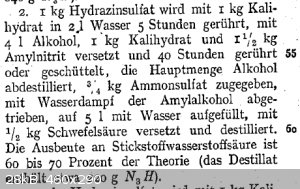
|
|
|
Thraxx
Hazard to Self
 
Posts: 71
Registered: 15-10-2016
Member Is Offline
Mood: No Mood
|
|
I would like to tell you,that after 12 experiments with IP extract + IPnitrite + hydroxide was my yields of azid only 2,5 g from first experiment (
hydroxid was there in Ethanol and partialy not diluted).In all other cases I produced amorphic yellow material,solubile in watter but
recrystalisation with alcohol is not possible it turns into brown liquid solubile in watter and insolubile in alcohol or into nothing.This liquid
react with AgNO3,but product is not energetic material.
I am sure,that I did some mistake,but I dont understand it.
Similar reaction is method of Opelkin,which gave Hydrazine hydrate + NaOH (solid? aquous?) + Ethylnitrite + ether.12 h in ice,12 h at RT.
Could be the IP extract/IP nitrite method better with ether?
Method of Thiele: 5 g Hydrazine hydrate + 37,5ml 4N solution of Natrium methylate + 12,5ml ethlylnitrite + 50ml ether
Method of Opelkin: stechiometric mix of NaOH + Hydraz.hydrate + ethylnitrite + ether
--
Method of Tanatar /Ber.32,S .1409/-hydrazin hydrate + NCl3(benzene solution)= HN3 + HCL
((my idea: Hydrazine sulf.+ aq.NaOH + NH4Cl --electrolysis==NaN3+NaCl))
---
Method of Curtius-hydrazine hydrate + HNO2== HN3+2H2O
Curtius- Kraus - hydrazine sulfate +KNO2 + H2SO4 all diluted and cooled in ice,,after foaming distillation.
((my idea: mix of Curtius/Kraus in adding funel on the two neck bottle dropped into boiling watter,the second neck has an usually cooler and
distilled into bottle with NaOH solution.))
Method of Sobanejeff and Djengin(1899)-hydrazine sulphate 1,5g + 4 ml of HNO3/1,3/ bubbled through AgNO3.
[Edited on 15-10-2016 by Thraxx]
[Edited on 15-10-2016 by Thraxx]
|
|
|
Theoretic
National Hazard
   
Posts: 776
Registered: 17-6-2003
Location: London, the Land of Sun, Summer and Snow
Member Is Offline
Mood: eating the souls of dust mites
|
|
Quote: Originally posted by Thraxx  | Method of Tanatar /Ber.32,S .1409/-hydrazin hydrate + NCl3(benzene solution)= HN3 + HCL
((my idea: Hydrazine sulf.+ aq.NaOH + NH4Cl --electrolysis==NaN3+NaCl))
[...]
Method of Sobanejeff and Djengin(1899)-hydrazine sulphate 1,5g + 4 ml of HNO3/1,3/ bubbled through AgNO3.
|
The first method is very interesting due to using a -III oxidation state nitrogen species, as the oxidizer. It is similar in principle to the Raschig
hydrazine synthesis, where ammonia/amide nucleophilically attacks chloramine (here hydrazine attacks NCl3), and resembles it more than the
Curtius reaction!
However the electrolysis won't work, since chloramine (which you will get before trichloramine) quickly reacts with hydrazine and destroys it. This is
the biggest issue in the Raschig process where chloramine concentration needs to be as low as possible.
The second one is cryptic. How does nitric acid create HN3? If it's reduced by hydrazine to nitrous acid first, that's wasteful of
hydrazine. The role of the silver nitrate is mysterious, and even more so what is being "bubbled" through it. There are no gases there.
|
|
|
Thraxx
Hazard to Self
 
Posts: 71
Registered: 15-10-2016
Member Is Offline
Mood: No Mood
|
|
To the NCl 3 method-
Hentschel (,Ber.1897,30,1434,1792) wrote,that NH4Cl react with sodium hypochlorite to form NCl3.
If the Tanatar wrote,that the NCl3 form with hydrazine the HN3,and if we do the hydrazine from NaClO,then it seems me be possible into reacted mix of
Urea/NaOH/inhibitor/NaClO give the mix of NaClO + NH4Cl and expect ,that the NaN3 will be formed.(?)
To the methods of Thiele and Stolle-(isnt it the same publicated in the same time ?)
1866-Griess -Ann 137,39- Phenylazide from Benzenediazonium perbromide +NH4OH .
1878-Fischer- -Phenylazide from Phenylnitroso hydrazine + KOH
1890-Curtius -Benzoylazide +NaOH+Na ethylate
1907-Dennis and Isham -Azoimide
1908-Thiele-Ber.41,2681(1908)-ethylnitrite used
1908-Stolle-Ber.41,2811(1908)-amylnitrite used
To the method of Curtius-why react the hydrazine with HNO2 to azoimide,if it could react to its salt-N2H4.HNO2,colorless explosive crystals from alc.
or ether.Moreover HN3 + HNO2==N +N2O + H2O.Therefore if there some azoimid toke place,then it should be destroyed.
[Edited on 15-10-2016 by Thraxx]
[Edited on 15-10-2016 by Thraxx]
[Edited on 15-10-2016 by Thraxx]
[Edited on 15-10-2016 by Thraxx]
|
|
|
Theoretic
National Hazard
   
Posts: 776
Registered: 17-6-2003
Location: London, the Land of Sun, Summer and Snow
Member Is Offline
Mood: eating the souls of dust mites
|
|
Chloramine reacts with hydrazine and destroys it. Did you even read my post.
"1866-Griess -Ann 137,39- Phenylazide from Benzenediazonium perbromide +NH4OH" - interesting variation. The N2 fragment has a nitrogen in a positive
oxidation state this time. And the N1 fragment gets halogenated as before, but after reacting with the N2 fragment.
|
|
|
Thraxx
Hazard to Self
 
Posts: 71
Registered: 15-10-2016
Member Is Offline
Mood: No Mood
|
|
I would like to ask you,what could be the substance on the picture below.
This is product of my twelve experiments with IP alcohol extract of hydrazine sulphate + NaOH and adition of IP nitrite + NaOH.
Ever was it the same problem-there precipitate yellow-brown amorph watter solubile substance and after filtration and dilution in watter and
precipitation with ethanol was this liquid outgoing .It is wattersoluble and non soluble in ethanol and aceton.
I dont know what it is or what it could be.Please help me ,this something is myChristmas.
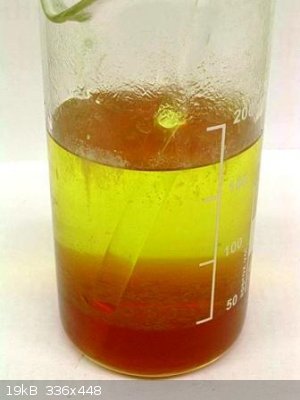 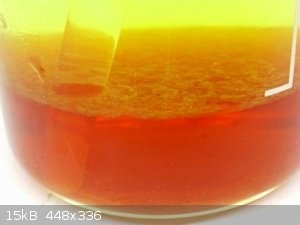
|
|
|
PHILOU Zrealone
International Hazard
    
Posts: 2893
Registered: 20-5-2002
Location: Brussel
Member Is Offline
Mood: Bis-diazo-dinitro-hydroquinonic
|
|
Quote: Originally posted by Thraxx  | I would like to ask you,what could be the substance on the picture below.
This is product of my twelve experiments with IP alcohol extract of hydrazine sulphate + NaOH and adition of IP nitrite + NaOH.
Ever was it the same problem-there precipitate yellow-brown amorph watter solubile substance and after filtration and dilution in watter and
precipitation with ethanol was this liquid outgoing .It is wattersoluble and non soluble in ethanol and aceton.
I dont know what it is or what it could be.Please help me ,this something is myChristmas. |
It is stange you get a yellow colour and a brown-orange phase splitting.
To me you must have an impurity somewhere into your proces.
I have played with chemically pure N2H4.H2O and NaNO2 both mixed into water solution doesn't display any yellow color...when phenol-phtalein is added
to both pink color is present but disappear when both solution are mixed (no bubbling) so maybe NaN3 formed?
I have played with N2H4.H2SO4 and NaOH and no yellow color.
I have played with N2H4.H2O and Cu(NO3)2, Co(NO3)2, Ni(NO3)2 and finally AgNO3...no yellow color...but beautiful colored complex precipitate
(explosives) or decomposition into bubbles.
The phase splitting must come from NaHSO4 or Na2SO4 and maybe NaOH --> soluble into water but not that much into organic solvents.
The brown color maybe from some iron ... but then one of your ingredients must already be yellow or colored (normally all must be colorless, white,
transparent); or maybe from oxydation of the isopropyl alcohol into aceton and crotonisation reaction with NaOH (brown tars)...but should be soluble
into organic solvents more than into water...
Are you sure you are not trying to fool us with a picture of TNT trial from toluen and medium concentrated HNO3?Doesn't it smell bitter almonds?
Really looks like nitrotoluen and dinitrotoluen oils...
[Edited on 12-1-2017 by PHILOU Zrealone]
PH Z (PHILOU Zrealone)
"Physic is all what never works; Chemistry is all what stinks and explodes!"-"Life that deadly disease, sexually transmitted."(W.Allen)
|
|
|
Thraxx
Hazard to Self
 
Posts: 71
Registered: 15-10-2016
Member Is Offline
Mood: No Mood
|
|
"Are you sure you are not trying to fool us with a picture of TNT trial from toluen and medium concentrated HNO3?Doesn't it smell bitter almonds?
Really looks like nitrotoluen and dinitrotoluen oils..."
I am sure,that it is not TNT and I am sure,that it is really problem for me,because I dont understand ,what this compound is or what it could be.May
it be some nitrite?
The reaction mix is colorless first ten hours,after turn it more and more yellow.
I will repeat the reaction and I will make pictures of it.
[Edited on 15-10-2016 by Thraxx]
|
|
|
Theoretic
National Hazard
   
Posts: 776
Registered: 17-6-2003
Location: London, the Land of Sun, Summer and Snow
Member Is Offline
Mood: eating the souls of dust mites
|
|
Philou: could this be oxidation of isopropyl nitrite, rather than isopropanol? Hydroxide E2 eliminates nitrite from IP nitrite, then the product is
acetone, which condenses as you said.
Thraxx how much did you heat the reaction? Heating and lots of NaOH may make this happen.
|
|
|
Thraxx
Hazard to Self
 
Posts: 71
Registered: 15-10-2016
Member Is Offline
Mood: No Mood
|
|
Quote: Originally posted by Theoretic  | Philou: could this be oxidation of isopropyl nitrite, rather than isopropanol? Hydroxide E2 eliminates nitrite from IP nitrite, then the product is
acetone, which condenses as you said.
Thraxx how much did you heat the reaction? Heating and lots of NaOH may make this happen. |
It was 12 reactions,only 2 was heated, 10 was cooled between -5 and 0 C .The heated was with liquid product,the cooled was with amorph product,which
turned into liquid during precipitation with ethanol.
This product is in acetone insoluble.
After I heated the product with conc.NaOH,because I though,that it is some kind of organic azid,but it does no reaction.
I tryied to react it with AgNO3 and there precipitate something,but it wasnt energetic .
|
|
|
PHILOU Zrealone
International Hazard
    
Posts: 2893
Registered: 20-5-2002
Location: Brussel
Member Is Offline
Mood: Bis-diazo-dinitro-hydroquinonic
|
|
Quote: Originally posted by Thraxx  | Quote: Originally posted by Theoretic  | Philou: could this be oxidation of isopropyl nitrite, rather than isopropanol? Hydroxide E2 eliminates nitrite from IP nitrite, then the product is
acetone, which condenses as you said.
Thraxx how much did you heat the reaction? Heating and lots of NaOH may make this happen. |
It was 12 reactions,only 2 was heated, 10 was cooled between -5 and 0 C .The heated was with liquid product,the cooled was with amorph product,which
turned into liquid during precipitation with ethanol.
This product is in acetone insoluble.
After I heated the product with conc.NaOH,because I though,that it is some kind of organic azid,but it does no reaction.
I tryied to react it with AgNO3 and there precipitate something,but it wasnt energetic . |
@Theoretic,
If OH(-) eliminates nitrite from isopropyl nitrite it will be as NO2(-) and "isopropyl hydroxyde" what is the same as 2-hydroxy-propan, as 2-propanol
or as isopropanol...the reverse of the ester formation --> hydrolysis.
So
Alk-O-N=O + OH(-) --> Alk-OH + ONO(-)
(CH3)2CH-O-N=O + NaOH -aq-> (CH3)2CH-OH + NaNO2
No oxydoredox involved and so no variation of oxydation state thus no aceton/propanon from isopropanol that way.
@Thraxx,
You didn't gave an answer about the purity of your reactants.
Commercial aceton, NaOH or isopropanol may get some crap % of impurities. NaNO2 may aswel depending on its proces.
Test with AgNO3 will give a precipitate with many compounds into your reaction media:
-nitrite; AgNO2 is a white-precipitate that darkens under light.
-hydroxyde; AgOH is turning instantaneously into black-brown Ag2O.
-hydrazine; generally decomposed as N2 and silver mirror or black colloidal Ag
-sulfate; yield unsoluble Ag2SO4
-azide; yielding AgN3 precipitate
-other unknown crap...many Ag(+) salts are unsoluble or weakly soluble precipitates
[Edited on 13-1-2017 by PHILOU Zrealone]
PH Z (PHILOU Zrealone)
"Physic is all what never works; Chemistry is all what stinks and explodes!"-"Life that deadly disease, sexually transmitted."(W.Allen)
|
|
|
Thraxx
Hazard to Self
 
Posts: 71
Registered: 15-10-2016
Member Is Offline
Mood: No Mood
|
|
@Thraxx,
"You didn't gave an answer about the purity of your reactants.
Commercial aceton, NaOH or isopropanol may get some crap % of impurities. NaNO2 may aswel depending on its proces."
Purity... NaNO2- P.a.
IP alcohol- pure
KOH-pure
NaOH-technical grade
IP nitrite-(made with HCl technical grade) new before each reaction,but only 2x washed through shaking with 0,5l watter.
Rations and possible mistakes :
1.extraction (Hydr.sulf. 1 mol + 1mol hydroxid +IPA (50 ml for each 30g of HS )IPA for 20 min to 5 h,either cooled in ice or heated in bath+ 1 mol
hydroxid for 30 min.)
2. extraction with other 50 ml IPA/30g HS
In more cases,if was it cooled in ice was the separation bed and I must use vac.filtration.
3. To the extract was added solution of 1 mol hydroxide in bigger amount of IP alcohol or in watter and after shaking was added 1 mol of IPnitrite.
May be ,that in extract was not enaught of hydrazine hydrate and the amount of IPnitrite and hydroxide was too big.
May be,that the solution of hydroxide in IP alcohol was poridge with small pieces of hydroxid,which came into touch with IP nitrite and caused its
destruction.
In these days I will repeat the reaction and its pictures with description I will give here.
---once more-on the picture of the strange liquid there is something about 50 ml. It stay all night in freeze below the window and now is there only
about 30 ml.It seems me like alcohol in thermometer.Could the liquid be something like eutectic solution of NaNO2 in IP alcohol?
[Edited on 15-10-2016 by Thraxx]
[Edited on 15-10-2016 by Thraxx]
[Edited on 15-10-2016 by Thraxx]
|
|
|
Thraxx
Hazard to Self
 
Posts: 71
Registered: 15-10-2016
Member Is Offline
Mood: No Mood
|
|
Semicarbazide ?
I decided me to do semikarbazide and from it make the sodium azide.This method I found elsewhere here in this forum.
Semikarbazid from monochlorurea:
1). solution of 9 g Urea in 125 ml watter -
2) 150 ml bleach slowly with little strom pour to the solution (1)
-
3) solution of 2g ZnCl2 diluted in 50 ml of 20% NH4OH -
4) boil it to lost of smell
5) give there second 50ml 20% NH4OH
6) boil it to dryiness-I did it on flat steel beaker behind window and there was a terrible much of foam-pic 4 and 5
7)after evaporation there was not much of product of Semicarbazide?.
8) To this product I poured a lot of 30% HCl and there precipitated white crystals,which I though was Semicarbazide Chlorid,which I filtered.. There
was about 5 g of it.
9) For to make azide of this stuff ,I diluted it in 5 ml watter and gave there 5g NaNO2(solution).In this moment should turn the semikarbazide chlorid
into Carbamoylazide,which is very good solubile in watter and alcohol.But there appear white precipitate.But I wanted azid and therefore I added there
5g of NaOH(solution) an boiled it.The precipitat stay there.But I wanted azide and therefore I gave there some amount of watter,and after amount of
alcohol for precipitation of the wanted azide.Solution ,brown collored really begann precipitate something dark.
conclusion- I think,that the product is or better was hydrazinodicarbonic acid diazide.
[/file] 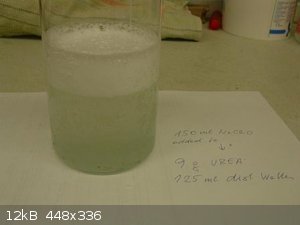 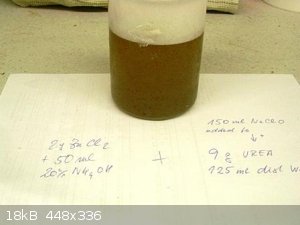 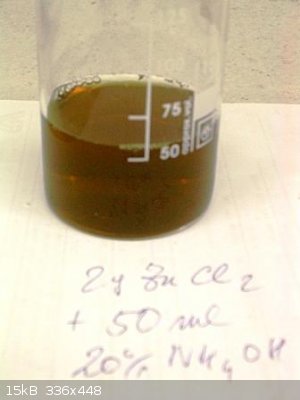 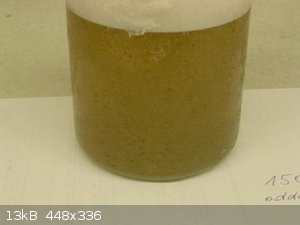 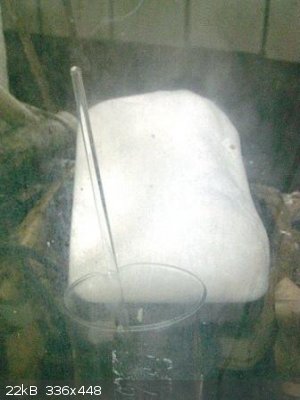 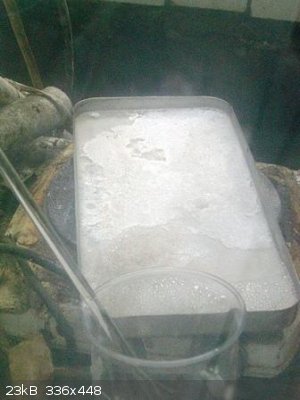 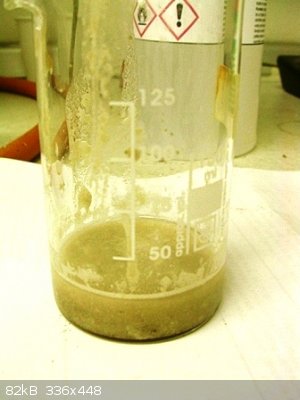 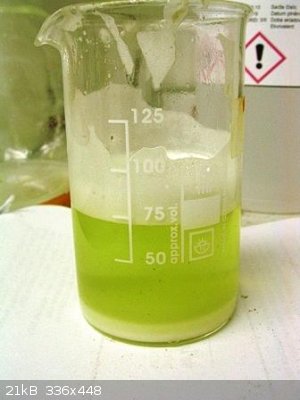  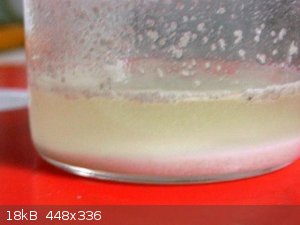 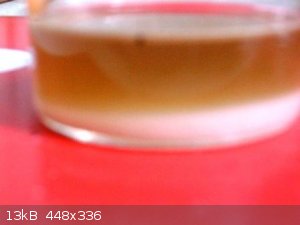
[Edited on 15-10-2016 by Thraxx]
[Edited on 15-10-2016 by Thraxx]
|
|
|
Theoretic
National Hazard
   
Posts: 776
Registered: 17-6-2003
Location: London, the Land of Sun, Summer and Snow
Member Is Offline
Mood: eating the souls of dust mites
|
|
It won't! That's substitution you're talking about; it's not elimination. That's why I specifically said "Hydroxide E2 eliminates nitrite
from IP nitrite". E2 elimination.
OH- won't displace nitrite to form isopropanol; OH- isn't a very good nucleophile and NO2 isn't a very good leaving group, with the C-N
sigma* antibonding orbital at a too-high energy to react with hydroxide.
If hydroxide ever 'displaces' the nitrite, it happens by addition to the N center, then elimination of isopropoxide anion.
[Edited on 16-1-2017 by Theoretic]
|
|
|
| Pages:
1
..
13
14
15
16
17
18 |